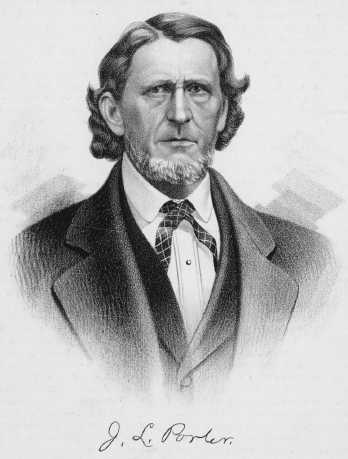in some inviting nook by night, as
they journeyed in this somewhat primitive way, they
presently arrived, without meeting, as far as is
known, any special incident or any adventure, in
Montgomery County, Ind. The land of this district,
although heavily timbered, was rich and fertile,
promising abundant recompense for any labor
intelligently directed that might be bestowed upon it.
Here, then, the family determined to settle, and
procured a tract of land about eight miles from
Crawfordsville. Speedily trees were felled, logs were
hewn, and a primitive mortar manufactured. Then, with
strong hands and hopeful hearts, they raised their
cabin--the home in the wilderness. That pioneer home
presented a striking contrast, we would not say to the
palatial residences upon the boulevards of our great
cities, but the present pioneer homes of such
districts as Montana, Dakota or Idaho. Its furniture,
like its walls, doors and roof, was the work of their
own hands, and a thousand and one conveniences and
necessaries, as we call them, were conspicuous by
their absence. Nevertheless, it was, in the truest
sense, "home."
Of work there was plenty for each
and all to do. The fathers and sons were employed,
even to the youngest, in clearing and preparing the
ground for the reception of seeds and cuttings, the
mother, besides her household and dairy work, in
spinning and weaving material for clothing and other
purposes. At that time deer, wild turkeys, and a large
variety of other game, abounded in the district;
naturally, therefore, James became a very expert
hunter, and doubtless learned in this school lessons
of self-control, caution, tact and patience, no less
valuable because not learned, as were his other
lessons, from a well-thumbed speller and reader in the
log school-house. School-house, did we say? It were
hard to recognize in that little log cabin, with its
rough door and rougher benches, an institution of
learning; and yet, 'tis even so, and, day by day, the
sunlight struggled to gain an entrance through the
oiled paper that served for a window, if, by any
chance, it might aid in illuminating the undeveloped
but capable intelligences there present, many of them
destined to make their mark in the days of larger
opportunity and horizon.
When twenty-five years of age James
L. Porter left home for Missouri, where he made good
progress, working as a carpenter in Lawrence County.
He continued to reside in that State for some twelve
years, and in 1851 proceeded to Iowa, where he
purchased a tract of wild prairie land in Harrison
County, and gave his attention to agricultural
pursuits. Having built his house and farm building, he
made various and important improvements from time to
time, and continued to make that his place of
residence until 1866, when he sold out and came to
Nebraska. This removal, similar to that of his earlier
recollections, was made in primitive style, by team,
for, unlike the pioneer of the present date, he found
no bands of steel, lightning express and vestibule
train, to carry him to the door of his "claim shanty."
He now bought land west of Lincoln, but after a time
took up a homestead four miles south of Lincoln,
living first in a sod house until he could erect more
substantial buildings. Upon this farm he continued to
make his home until the fall of 1870, when he again
sold out, and settled where he now resides, on section
29, Middle Creek Precinct.
In Phebe McMullen, a native of Ohio,
Mr. Porter found a lady who possessed every
qualification to adorn his home and complete his
life's interest. Accordingly they were married Sept.
29, 1842. They are both members of the Primitive
Methodist Church, in which communion they find
congenial surroundings and thought, which harmonize
with their religious convictions. Mr. and Mrs. Porter
are the parents of six children, three of whom are
living, named as follows: John R., Francis M. and
Scyrus N.; the two last named are married, and live in
Middle Creek Precinct.
As we have already noted, as a
necessary result of his pioneer life, the educational
advantages enjoyed by Mr. Porter were very few and
limited in scope, but being the happy possessor of a
studious mind, logical thought and retentive memory,
we see him grasping every opportunity., using the same
to the fullest extent, until he has educated himself
for business and social life, not forgetting also
fitness for the duties and responsibilities of
citizenship. His orchards are among the finest in the
country, containing upward of 300 well-selected trees.
In addition, he has also an extensive seed
|


